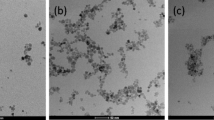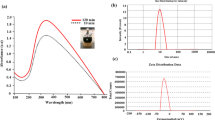Abstract
The study aims to synthesize and homogeneously functionalize iron oxide nanoparticles (IONPs) using a non-thermal atmospheric pressure (NTAP) plasma for biological applications. IONPs were synthesized using a new NTAP plasma assisted electrolysis technique. The utilization of a unique NTAP plasma rotating reactor allows for a uniform surface functionalization throughout the IONP surface. The precursor used for the functionalization process was acrylic acid (AAc), and it was carried out in response to the applied voltage and monomer flow rate. Optical emission spectroscopy (OES) was used to investigate the reactive species in-situ throughout the functionalization process. Vibrating-sample magnetometry (VSM), energy dispersive X-ray analysis (EDX), X-ray diffraction (XRD), field emission scanning electron microscopy (FE-SEM), and X-ray photo electron spectroscopy (XPS) were used to analyse the changes in the chemical, structural, morphological, and magnetic properties of the untreated and functionalized IONPs. Subsequently, chemical dosimetry and the in vitro metabolic activity assay (MTT) were used to analyse the OH• radical production capacity and toxicity of IONPs. The findings showed that the experimental working conditions had a significant impact on retaining the distinctive COOH functional groups on the surface of functionalized IONPs. The coexistence of the hematite (Fe2O3) and magnetite (Fe3O4) phases is revealed by the untreated and functionalized IONPs, which also exhibit marked super paramagnetic performance and a spherical shape. In the end, the IONPs demonstrated clear nontoxicity when they were functionalized at greater flow rates and reduced applied voltage. The analysis results unequivocally demonstrated the functionalized IONPs’ non-toxicity, highlighting their prospective application in the field of biomedicine.


















Similar content being viewed by others
Explore related subjects
Discover the latest articles and news from researchers in related subjects, suggested using machine learning.Data Availability
No datasets were generated or analysed during the current study.
References
Arsalania S, Oliveira J, Guidellia EJ, Araujoc JFDF, Wiekhorstb F, Baffa O (2020) Synthesis of radioluminescent iron oxide nanoparticles functionalized by anthracene for biomedical applications. Colloids Surf a 602:125105
Lu AH, Salabas EL, Schüth F (2007) Magnetic nanoparticles: synthesis, protection, functionalization, and application, Angew. Chemie Int Ed 46(8):1222–1244
Lu H, Yi G, Zhao S, Chen D, Guo L-H, Cheng J (2004) Synthesis and characterization of multi-functional nanoparticles possessing magnetic, up-conversion fluorescence and bio-affinity properties. J Mater Chem 14(8):1336–1341
Weimuller MG, Zeisberger M, Krishnan KM (2009) Size-dependant heating rates of iron oxide nanoparticles for magnetic fluid hyperthermia. J Magn Magn Mater 321(13):1947–1950
Kayal S, Ramanujan R (2010) Doxorubicin loaded PVA coated iron oxide nanoparticles for targeted drug delivery. Mater Sci Eng C 30(3):484–490
Kandasamy PG, Soni S, Sushmita K, Veerapu NS, Bose S, Maity D (2019) One-step synthesis of hydrophilic functionalized and cytocompatible superparamagnetic iron oxide nanoparticles (SPIONs) based aqueous ferrofluids for biomedical applications author links open overlay. J Mol Liq 274:653–663
Gambhir RP, Rohiwal SS, Tiwari AP (2022) Multifunctional surface functionalized magnetic iron oxide nanoparticles for biomedical applications: a review. Appl Surf Sci Adv 11:100303
AL-Harbi LM, Mohamed SA, Darwish (2022) Functionalized iron oxide nanoparticles: synthesis through ultrasonic-assisted co-precipitation and performance as hyperthermic agents for biomedical applications. Heliyon 8(6):e09654
Nahar Y, Rahman MA, Hossain MK, Sharafat MK, Karim MR, Elaissari A, Ochiai B, Ahmad H, Rahman MM (2020) A facile one-pot synthesis of poly(acrylic acid)-functionalized magnetic iron oxide nanoparticles for suppressing reactive oxygen species generation and adsorption of biocatalyst. Mater Res Express 7:016102
Toyokuni S (1996) Iron induced carcinogenesis: the role of redox regulation. Free Radic Biol Med 20:553–566
Ghosh P, Kumar C, Samatha A N, Ray S, (2012),Comparison of a new immobilized Fe3+ catalyst with homogeneous Fe3+–H2O2 system for degradation of 2,4‐dinitrophenol, J Chem Technol Biotechnol, 87: 914-923
Faruq M, Yusof N A, (2014) Surface ligand influenced free radical protection of superparamagnetic iron oxide nanoparticles (SPIONs) toward H9c2 cardiac cells, J.Mater Sci, 49: 6290–6301
Elrahmana AAA, Mansour FR (2019) Targeted magnetic iron oxide nanoparticles: Preparation, functionalization and biomedical application. J Drug Deliv Sci Tec 52:702–712
Borcia G, Anderson CA, Brown NMD (2004) The surface oxidation of selected polymers using an atmospheric pressure air dielectric barrier discharge, part I. Appl Surf Sci 221:203–214
Akishev Y, Grushin M, Dyatko N, Kochetov I, Napartovich A, Trushkin N, Duc TM, Descours S (2008) Studies on cold plasma–polymer surface interaction by example of PP- and PET-films. J Phys D Appl Phys 41:235203
Tanasa E, Zaharia C, Radu IC, Surdu VA, Vasile BS, Damian CM, Andronescu E (2019) Novel nanocomposites based on functionalized magnetic nanoparticles and polyacrylamide: Preparation and complex characterization. J Nanomater 9:1384
Zhang F, Yu S, Hou G, Xu N, Wu Z (2015) Lu Yue, Miniemulsion-based assembly of iron oxide nanoparticles and synthesis of magnetic polymer nanospheres. Colloid Polym Sci 293:1893–1902
Faber H, Hirschmann J, Klaumunzer M, Braunschweig B, Peukert W, Halik M (2012) ACS Appl Mater Interfaces 4(3):1693–1696
Morent R, De Geyter N, Verschuren J, De Clerck K, Kiekens P, Leys C (2008) Non-thermal plasma treatment of textiles. Surf Coat Technol 202:3427–3449
N. Encinas, B. Díaz-Benito, J. Abenojar, M.A. Martínez, Surf. Coat. Technol. 205 (2010) 396.2089.
Kholodkov I, Biederman H, Slavınsk D, Choukourov A (2003) Vacuum 70:505
Popelka A, Kronek J, Novak I, Kleinova A, Miusík M, Spírkova M, Omastova M (2014) Vacuum 100:53
Navaneetha Pandiyaraj K, Karuppusamy M, Jayamurugan P, Misra VC, Ghorui S, Saravanan P, Nadagouda MN, Unnikrishnane BS, Gopinath P, Pichumani M (2024) Rouba Ghobeira, Nathalie De Geyter, Rino Morent, Adv. Powder Technol, 35 104441
Morent R, De Geyter N, Vlierberghe SV, Beaurain A, Dubruel P, Payenc E (2011) Influence of operating parameters on plasma polymerization of acrylic acid in amesh-to-plate dielectric barrier discharge. Prog Org Coat 70:336–341
Rutnakornpituk N, Puangsin P Theamdee Band Rutnakornpituk U2011 Wichai, Polymer 52987
Kanazawa S, Furuki T, Nakaji T, Akamine S, Ichiki R (2012) Measurement of OH radicals in aqueous solution produced by atmospheric-pressure LF plasma jet. Int J Plasma Environ Sci Technol 6:166–171
Pandiyaraj KN, Vasu D, Ghobeira R, Tabaei PSE, De Geyter N, Morent R, Pichumani M, Padmanabhanan PVA, Deshmukh RR (2021) Dye wastewater degradation by the synergetic effect of an atmospheric pressure plasma treatment and the photocatalytic activity of plasma-functionalized Cu-TiO2 nanoparticles. J Hazard Mater 405:124264
Kim YH, Hong YJ, Baik KY, Kwon GC, Choi JJ, Cho GS, Uhm HS, Kim DY, Choi EH (2014) Measurement of reactive hydroxyl radical species inside the biosolutions during non-thermal atmospheric pressure plasma jet bombardment onto the solution. Plasma Chem Plasma Process 34:457–472
National Institute of Standard and Technology (NIST Database) (https://physics.nist.gov/PhysRefData/Handbook/periodictable.htm)
Shaw P, Kumar N, Kwak HS (2018) Bacterial inactivation by plasma treated water enhanced by reactive nitrogen species. Sci Rep 8:11268
Attri P, Kim Y, Park D et al (2015) Generation mechanism of hydroxyl radical species and its lifetime prediction during the plasma-initiated ultraviolet (UV) photolysis. Sci Rep 5:9332
Chang Y-J, Lin C-H, Huang C (2016) Plasma polymerization of acrylic acid onto polystyrene by cyclonic plasma at atmospheric pressure Jpn. J Appl Phys 55:01AB05
Pandiyaraj KN, Ramkumar MC, Arun Kumar A, Vasu D, Padmanabhan PVA, Tabaei PSE, Cools P, De Geyter N, Morent R, Jaganathan SK (2019) Development of phosphor containing functional coatings via cold atmospheric pressure plasma jet - study of various operating parameters. Appl Surf Sci 488:343–350
Beamson G, Briggs D (1992) High Resolution XPS of Organic polymers: the ScientaESCA300 database. Wiley, New York
Yasuda H (1981) J Polym Sci Macromol Rev 16:199–293
De Geyter N, Morent R, Vlierberghe SV, Dubruel P, Leys C, Gengembre L, Schacht E, Payen E (2009) Deposition of polymethyl methacrylate on polypropylene substrates using an atmospheric pressure dielectric barrier discharge. Prog Org Coat 64(2–3):230–237
Pandiyaraj KN, Arun Kumar A, RamKumar MC, Padmanabhan PVA, Trimukhe AM, Deshmukh RR, Cools P, Morent R, De Geyter N, Kumar V, Gopinath P, Jaganathan SK (2018) Influence of operating parameters on development of polyethylene oxide like coatings on the surfaces of polypropylene films by atmospheric pressure cold plasma jet-assisted polymerization to enhance their antifouling properties. J Phys Chem Solid 123:76–86
Ruíz-Baltazar AJ (2021) Sonochemical activation-assisted biosynthesis of Au/ Fe3O4 nanoparticles and sonocatalytic degradation of methyl orange. Ultrason Sonochem 73:105521
Tayefeha A, Poursalehi R, Wiesnerb M, Mousavi SA (2019) XPS study of size effects of Fe3O4 nanoparticles on crosslinking degree of magnetic TFN membrane. Polym Test 73:232–241
Ni X, Zhang J, Zhao L, Wang F, He H, Dramou P (2022) Study of the solvothermal method time variation effects on magnetic iron oxide nanoparticles (Fe3O4) features. J Phys Chem Solid 169:110855
V.E. Noval, J.G. Carriazo, Fe3O4-TiO2 and Fe3O4-SiO2 Core-shell powders synthesized from industrially processed magnetite (Fe3O4) Microparticles, Mater. Res. 22 (2019) e20180660.
M. Ayesha, A. Imran, I. Haider, S. Shahzadi, A. Moeen, W. Ul-Hami, A. Nabgan, T. Shahzadi, M. Alshahrani, Ikram, Polyvinylpyrrolidone and chitosan-coated magnetite (Fe3O4) nanoparticles for catalytic and antimicrobial activity with molecular docking analysis, J. Environ. Chem. Eng. 11 (2023) 110088.
J. Yu, B. Wang, Q. Lu, L. Xiao, X. Ma, Y. Feng, Y. Qian, Fabrication of Fe3O4 nanoparticles by using cathode glow discharge electrolysis plasma and its electrochemical properties, Electrochim. Acta 427 (2022) 140843.
N.K. Yetim, F. Kurs¸ UN. Baysak, M.M. Koc¸ and D. Nartop Characterization of magnetic Fe3O4@SiO2 nanoparticles with fluorescent properties for potential multipurpose imaging and theranostic applications, J Mater Sci: Mater Electron, 31 (2020)18278–18288.
M. Simeonov, A.A. Apostolov, M. Georgieva, D. Tzankov and E. Vassileva, Poly(acrylic acid-co-acrylamide)/Polyacrylamide pIPNs/Magnetite Composite Hydrogels: Synthesis and Characterization, Gels 9(5) (2023) 365.
T. Yeamsuksawat, Hui Zhao, Jun Liang, Characterization and antimicrobial performance of magnetic Fe3O4@Chitosan@Ag nanoparticles synthesized via suspension technique, Mater. Today Commun. 28 (2021) 102481.
B Wang, J J Yin, X Y Zhou, Physicochemical origin for free radical generation of iron oxide nanoparticles in biomicroenvironment: catalytic activities mediated by surface chemical states, J. Phys. Chem. C, 117(1) (2013) 383-392.
N Singh, B Manshian, and G J S Jenkins, NanoGenotoxicology: the DNA damaging potential of engineered nanomaterials. Biomater. 30 (23-24) (2009) 3891-3914.
Acknowledgements
The corresponding author Dr. K. Navaneetha Pandiyaraj would like to acknowledge the Department of Atomic Energy-Board of Research in Nuclear Sciences (DAE-BRNS) (57/14/01/2022-BRNS/34014, dated 01.06.2022), Government of India, for the financial support provided to conduct this research. The author M Pichumani is grateful to The Management, Sri Ramakrishna Engineering College, Coimbatore, India.
Author information
Authors and Affiliations
Contributions
K.N -Wrote the main manuscript M.K-Methodology V.C.M- Formal analysis and Funding S.G- Formal analysis and Funding PS-Methodology and Formal analysis M.N.N-Methodology and Formal analysis M.P-Methodology and Formal analysis S.P.S-Methodology and Formal analysis V.Z-Methodology and Formal analysis.
Corresponding author
Ethics declarations
Competing Interests
The authors declare no competing interests.
Additional information
Publisher’s Note
Springer Nature remains neutral with regard to jurisdictional claims in published maps and institutional affiliations.
Rights and permissions
Springer Nature or its licensor (e.g. a society or other partner) holds exclusive rights to this article under a publishing agreement with the author(s) or other rightsholder(s); author self-archiving of the accepted manuscript version of this article is solely governed by the terms of such publishing agreement and applicable law.
About this article
Cite this article
Pandiyaraj, K.N., Karuppusamy, M., Misra, V.C. et al. Development of Functionalized Iron Oxide Nanoparticles Through Non-Thermal Atmospheric Pressure Plasma Assisted Polymerization for Reducing Cytotoxicity. Plasma Chem Plasma Process 45, 133–159 (2025). https://doi.org/10.1007/s11090-024-10521-4
Received:
Accepted:
Published:
Issue Date:
DOI: https://doi.org/10.1007/s11090-024-10521-4
Keywords
Profiles
- Vandana Chaturvedi Misra View author profile




